PROJ6012 - Managing Information Systems/Technology Projects: Xero
VerifiedAdded on 2023/06/10
|21
|4872
|356
Case Study
AI Summary
This case study analyzes Information Systems/Technology projects at Xero, Australia, focusing on project management methodologies, strategic alignment, and organizational context. It evaluates Xero's current IT state, its dependency, and the impact of chosen projects on organizational success and society. The report justifies the selection of Agile methods, discusses tools for software development, and examines how strategic goals are aligned. It also addresses project scope, essential features, limitations, problems in scope changes, schedule planning, and methods for preventing project failure. The analysis includes a SWOT analysis and highlights the importance of adapting to changing customer dynamics and industries.
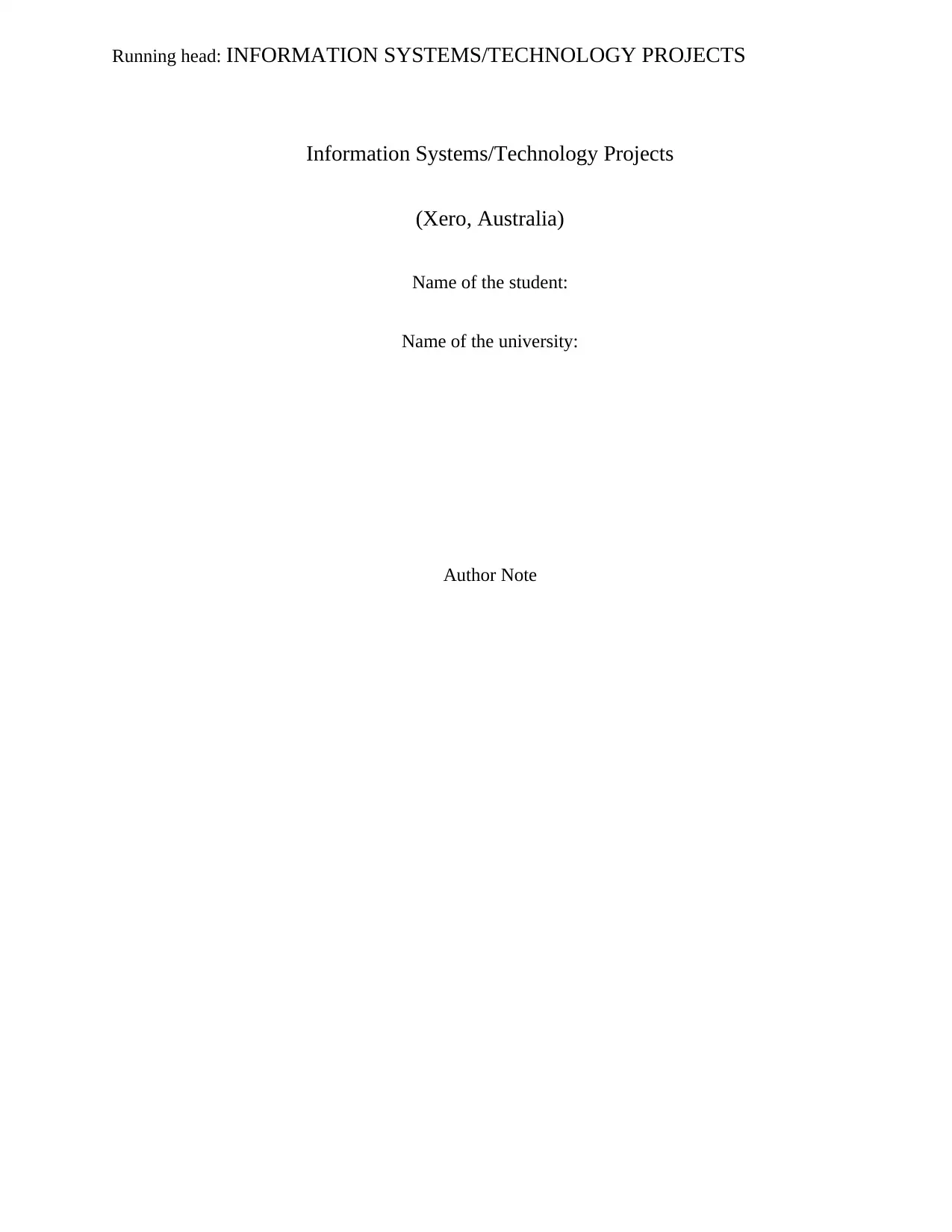
Running head: INFORMATION SYSTEMS/TECHNOLOGY PROJECTS
Information Systems/Technology Projects
(Xero, Australia)
Name of the student:
Name of the university:
Author Note
Information Systems/Technology Projects
(Xero, Australia)
Name of the student:
Name of the university:
Author Note
Paraphrase This Document
Need a fresh take? Get an instant paraphrase of this document with our AI Paraphraser
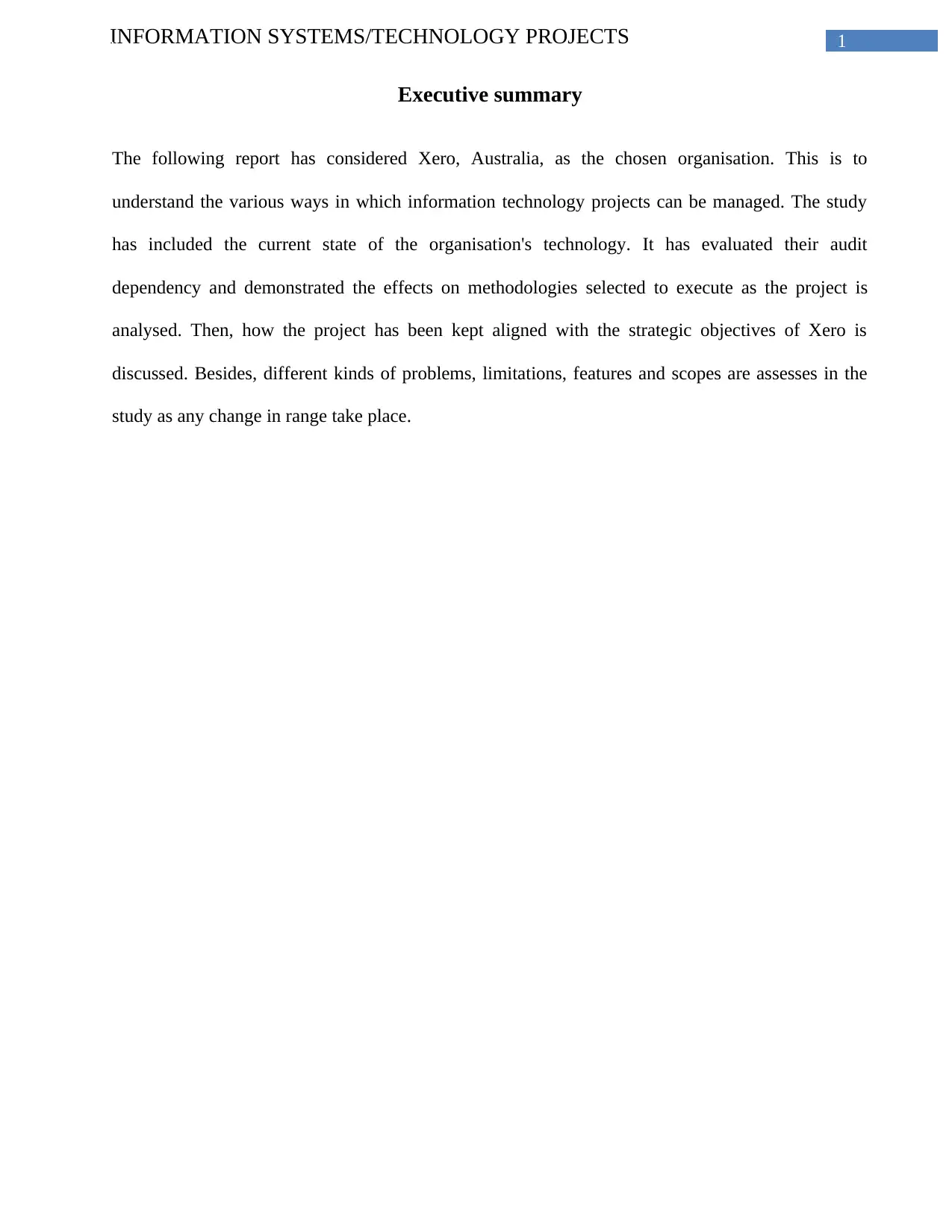
1INFORMATION SYSTEMS/TECHNOLOGY PROJECTS
Executive summary
The following report has considered Xero, Australia, as the chosen organisation. This is to
understand the various ways in which information technology projects can be managed. The study
has included the current state of the organisation's technology. It has evaluated their audit
dependency and demonstrated the effects on methodologies selected to execute as the project is
analysed. Then, how the project has been kept aligned with the strategic objectives of Xero is
discussed. Besides, different kinds of problems, limitations, features and scopes are assesses in the
study as any change in range take place.
Executive summary
The following report has considered Xero, Australia, as the chosen organisation. This is to
understand the various ways in which information technology projects can be managed. The study
has included the current state of the organisation's technology. It has evaluated their audit
dependency and demonstrated the effects on methodologies selected to execute as the project is
analysed. Then, how the project has been kept aligned with the strategic objectives of Xero is
discussed. Besides, different kinds of problems, limitations, features and scopes are assesses in the
study as any change in range take place.
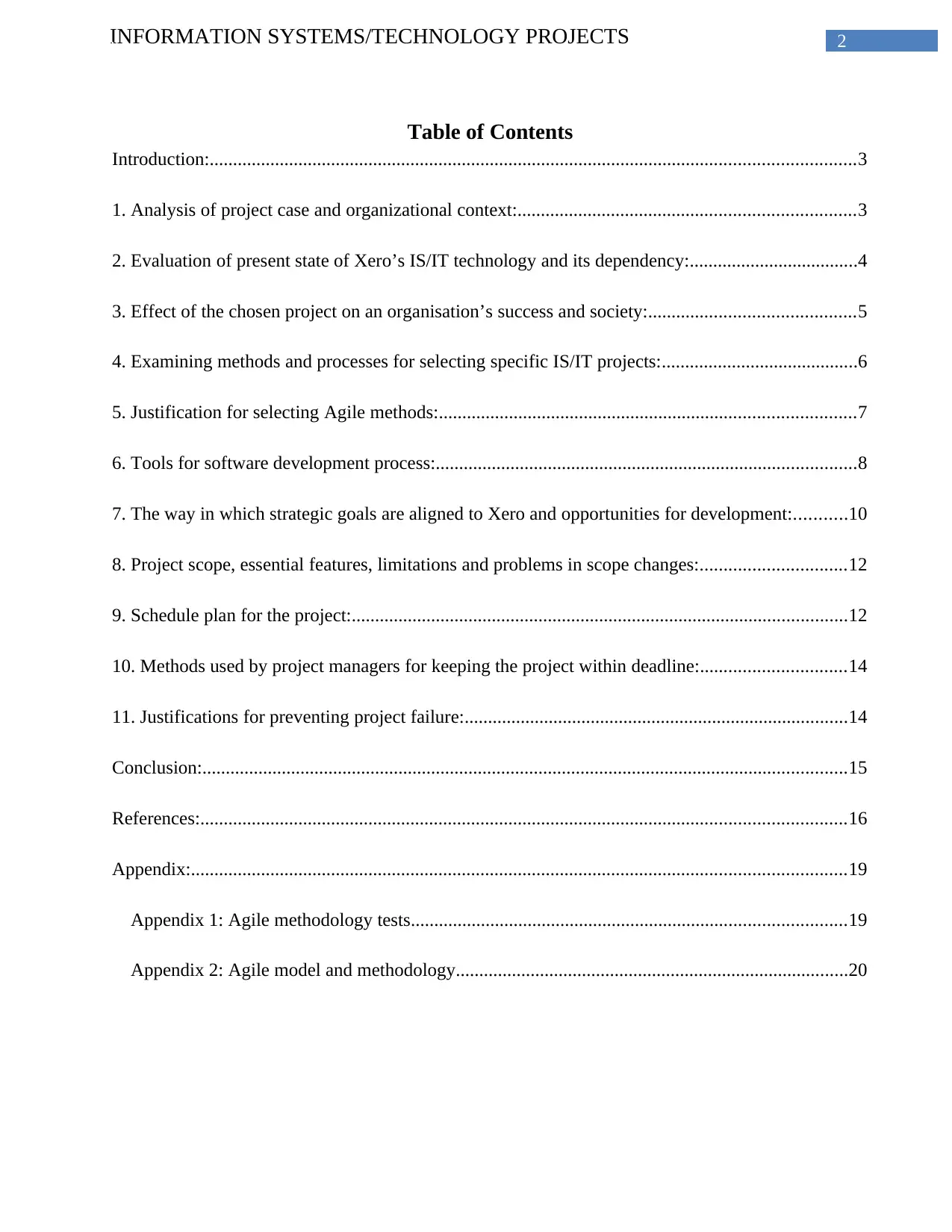
2INFORMATION SYSTEMS/TECHNOLOGY PROJECTS
Table of Contents
Introduction:..........................................................................................................................................3
1. Analysis of project case and organizational context:........................................................................3
2. Evaluation of present state of Xero’s IS/IT technology and its dependency:....................................4
3. Effect of the chosen project on an organisation’s success and society:............................................5
4. Examining methods and processes for selecting specific IS/IT projects:..........................................6
5. Justification for selecting Agile methods:.........................................................................................7
6. Tools for software development process:..........................................................................................8
7. The way in which strategic goals are aligned to Xero and opportunities for development:...........10
8. Project scope, essential features, limitations and problems in scope changes:...............................12
9. Schedule plan for the project:..........................................................................................................12
10. Methods used by project managers for keeping the project within deadline:...............................14
11. Justifications for preventing project failure:..................................................................................14
Conclusion:..........................................................................................................................................15
References:..........................................................................................................................................16
Appendix:............................................................................................................................................19
Appendix 1: Agile methodology tests.............................................................................................19
Appendix 2: Agile model and methodology....................................................................................20
Table of Contents
Introduction:..........................................................................................................................................3
1. Analysis of project case and organizational context:........................................................................3
2. Evaluation of present state of Xero’s IS/IT technology and its dependency:....................................4
3. Effect of the chosen project on an organisation’s success and society:............................................5
4. Examining methods and processes for selecting specific IS/IT projects:..........................................6
5. Justification for selecting Agile methods:.........................................................................................7
6. Tools for software development process:..........................................................................................8
7. The way in which strategic goals are aligned to Xero and opportunities for development:...........10
8. Project scope, essential features, limitations and problems in scope changes:...............................12
9. Schedule plan for the project:..........................................................................................................12
10. Methods used by project managers for keeping the project within deadline:...............................14
11. Justifications for preventing project failure:..................................................................................14
Conclusion:..........................................................................................................................................15
References:..........................................................................................................................................16
Appendix:............................................................................................................................................19
Appendix 1: Agile methodology tests.............................................................................................19
Appendix 2: Agile model and methodology....................................................................................20
⊘ This is a preview!⊘
Do you want full access?
Subscribe today to unlock all pages.

Trusted by 1+ million students worldwide
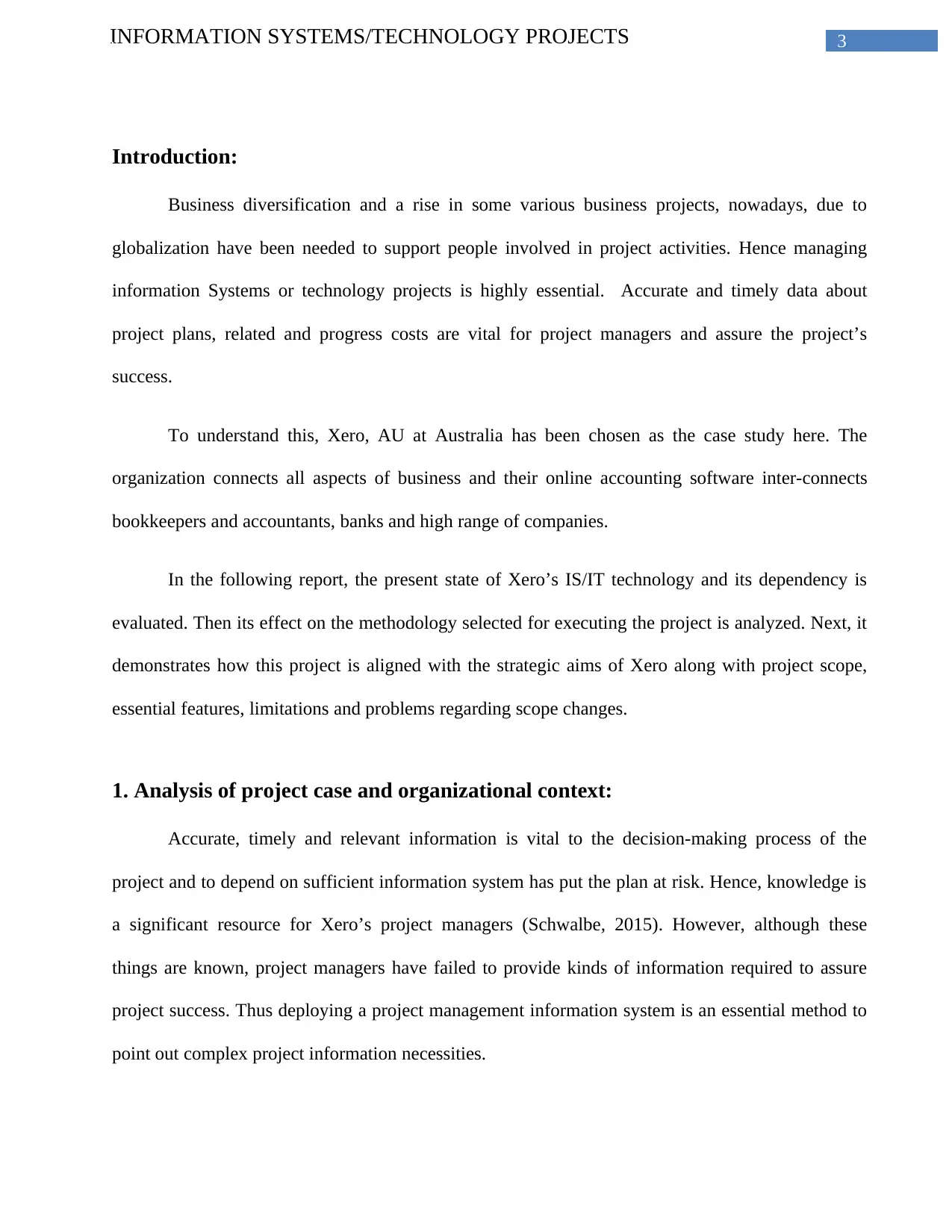
3INFORMATION SYSTEMS/TECHNOLOGY PROJECTS
Introduction:
Business diversification and a rise in some various business projects, nowadays, due to
globalization have been needed to support people involved in project activities. Hence managing
information Systems or technology projects is highly essential. Accurate and timely data about
project plans, related and progress costs are vital for project managers and assure the project’s
success.
To understand this, Xero, AU at Australia has been chosen as the case study here. The
organization connects all aspects of business and their online accounting software inter-connects
bookkeepers and accountants, banks and high range of companies.
In the following report, the present state of Xero’s IS/IT technology and its dependency is
evaluated. Then its effect on the methodology selected for executing the project is analyzed. Next, it
demonstrates how this project is aligned with the strategic aims of Xero along with project scope,
essential features, limitations and problems regarding scope changes.
1. Analysis of project case and organizational context:
Accurate, timely and relevant information is vital to the decision-making process of the
project and to depend on sufficient information system has put the plan at risk. Hence, knowledge is
a significant resource for Xero’s project managers (Schwalbe, 2015). However, although these
things are known, project managers have failed to provide kinds of information required to assure
project success. Thus deploying a project management information system is an essential method to
point out complex project information necessities.
Introduction:
Business diversification and a rise in some various business projects, nowadays, due to
globalization have been needed to support people involved in project activities. Hence managing
information Systems or technology projects is highly essential. Accurate and timely data about
project plans, related and progress costs are vital for project managers and assure the project’s
success.
To understand this, Xero, AU at Australia has been chosen as the case study here. The
organization connects all aspects of business and their online accounting software inter-connects
bookkeepers and accountants, banks and high range of companies.
In the following report, the present state of Xero’s IS/IT technology and its dependency is
evaluated. Then its effect on the methodology selected for executing the project is analyzed. Next, it
demonstrates how this project is aligned with the strategic aims of Xero along with project scope,
essential features, limitations and problems regarding scope changes.
1. Analysis of project case and organizational context:
Accurate, timely and relevant information is vital to the decision-making process of the
project and to depend on sufficient information system has put the plan at risk. Hence, knowledge is
a significant resource for Xero’s project managers (Schwalbe, 2015). However, although these
things are known, project managers have failed to provide kinds of information required to assure
project success. Thus deploying a project management information system is an essential method to
point out complex project information necessities.
Paraphrase This Document
Need a fresh take? Get an instant paraphrase of this document with our AI Paraphraser
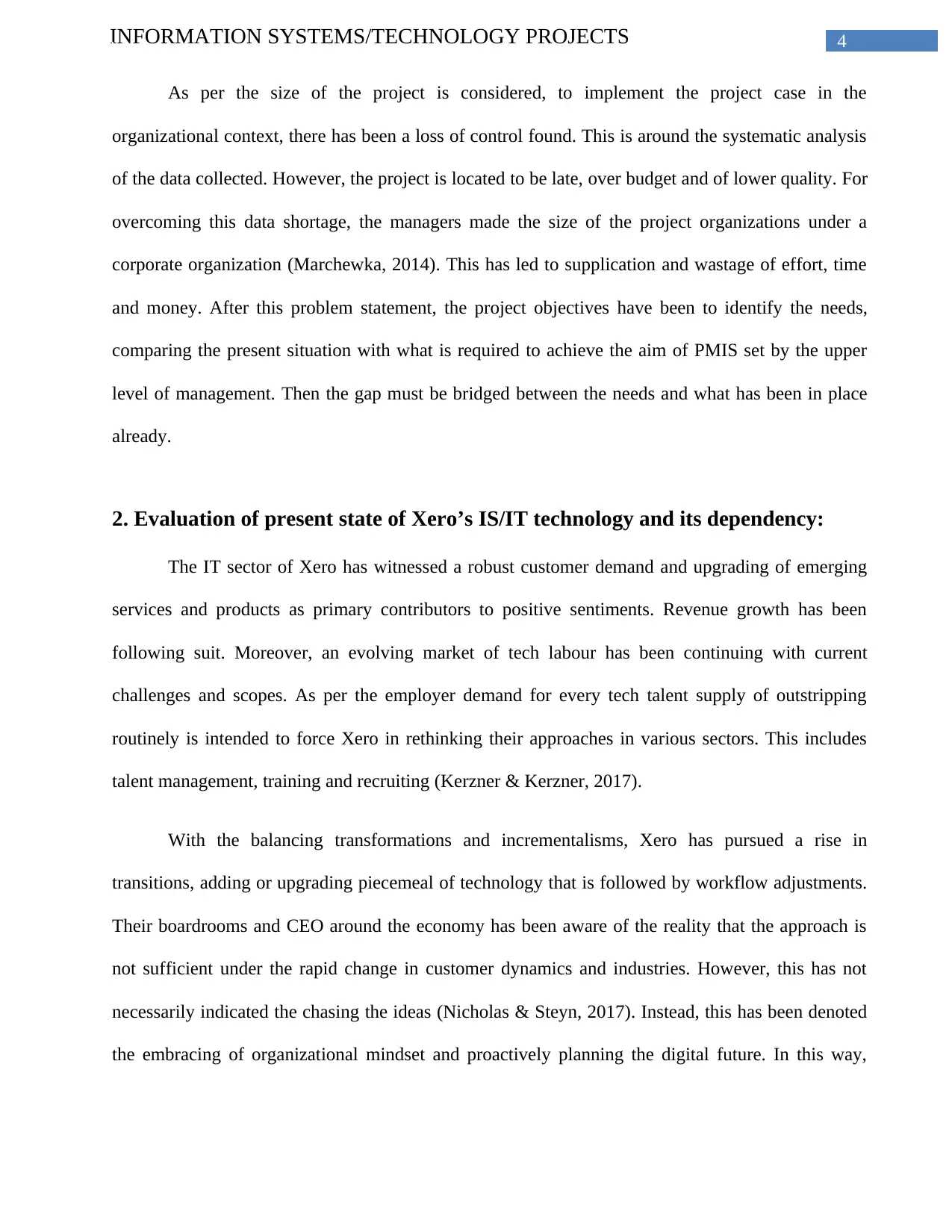
4INFORMATION SYSTEMS/TECHNOLOGY PROJECTS
As per the size of the project is considered, to implement the project case in the
organizational context, there has been a loss of control found. This is around the systematic analysis
of the data collected. However, the project is located to be late, over budget and of lower quality. For
overcoming this data shortage, the managers made the size of the project organizations under a
corporate organization (Marchewka, 2014). This has led to supplication and wastage of effort, time
and money. After this problem statement, the project objectives have been to identify the needs,
comparing the present situation with what is required to achieve the aim of PMIS set by the upper
level of management. Then the gap must be bridged between the needs and what has been in place
already.
2. Evaluation of present state of Xero’s IS/IT technology and its dependency:
The IT sector of Xero has witnessed a robust customer demand and upgrading of emerging
services and products as primary contributors to positive sentiments. Revenue growth has been
following suit. Moreover, an evolving market of tech labour has been continuing with current
challenges and scopes. As per the employer demand for every tech talent supply of outstripping
routinely is intended to force Xero in rethinking their approaches in various sectors. This includes
talent management, training and recruiting (Kerzner & Kerzner, 2017).
With the balancing transformations and incrementalisms, Xero has pursued a rise in
transitions, adding or upgrading piecemeal of technology that is followed by workflow adjustments.
Their boardrooms and CEO around the economy has been aware of the reality that the approach is
not sufficient under the rapid change in customer dynamics and industries. However, this has not
necessarily indicated the chasing the ideas (Nicholas & Steyn, 2017). Instead, this has been denoted
the embracing of organizational mindset and proactively planning the digital future. In this way,
As per the size of the project is considered, to implement the project case in the
organizational context, there has been a loss of control found. This is around the systematic analysis
of the data collected. However, the project is located to be late, over budget and of lower quality. For
overcoming this data shortage, the managers made the size of the project organizations under a
corporate organization (Marchewka, 2014). This has led to supplication and wastage of effort, time
and money. After this problem statement, the project objectives have been to identify the needs,
comparing the present situation with what is required to achieve the aim of PMIS set by the upper
level of management. Then the gap must be bridged between the needs and what has been in place
already.
2. Evaluation of present state of Xero’s IS/IT technology and its dependency:
The IT sector of Xero has witnessed a robust customer demand and upgrading of emerging
services and products as primary contributors to positive sentiments. Revenue growth has been
following suit. Moreover, an evolving market of tech labour has been continuing with current
challenges and scopes. As per the employer demand for every tech talent supply of outstripping
routinely is intended to force Xero in rethinking their approaches in various sectors. This includes
talent management, training and recruiting (Kerzner & Kerzner, 2017).
With the balancing transformations and incrementalisms, Xero has pursued a rise in
transitions, adding or upgrading piecemeal of technology that is followed by workflow adjustments.
Their boardrooms and CEO around the economy has been aware of the reality that the approach is
not sufficient under the rapid change in customer dynamics and industries. However, this has not
necessarily indicated the chasing the ideas (Nicholas & Steyn, 2017). Instead, this has been denoted
the embracing of organizational mindset and proactively planning the digital future. In this way,
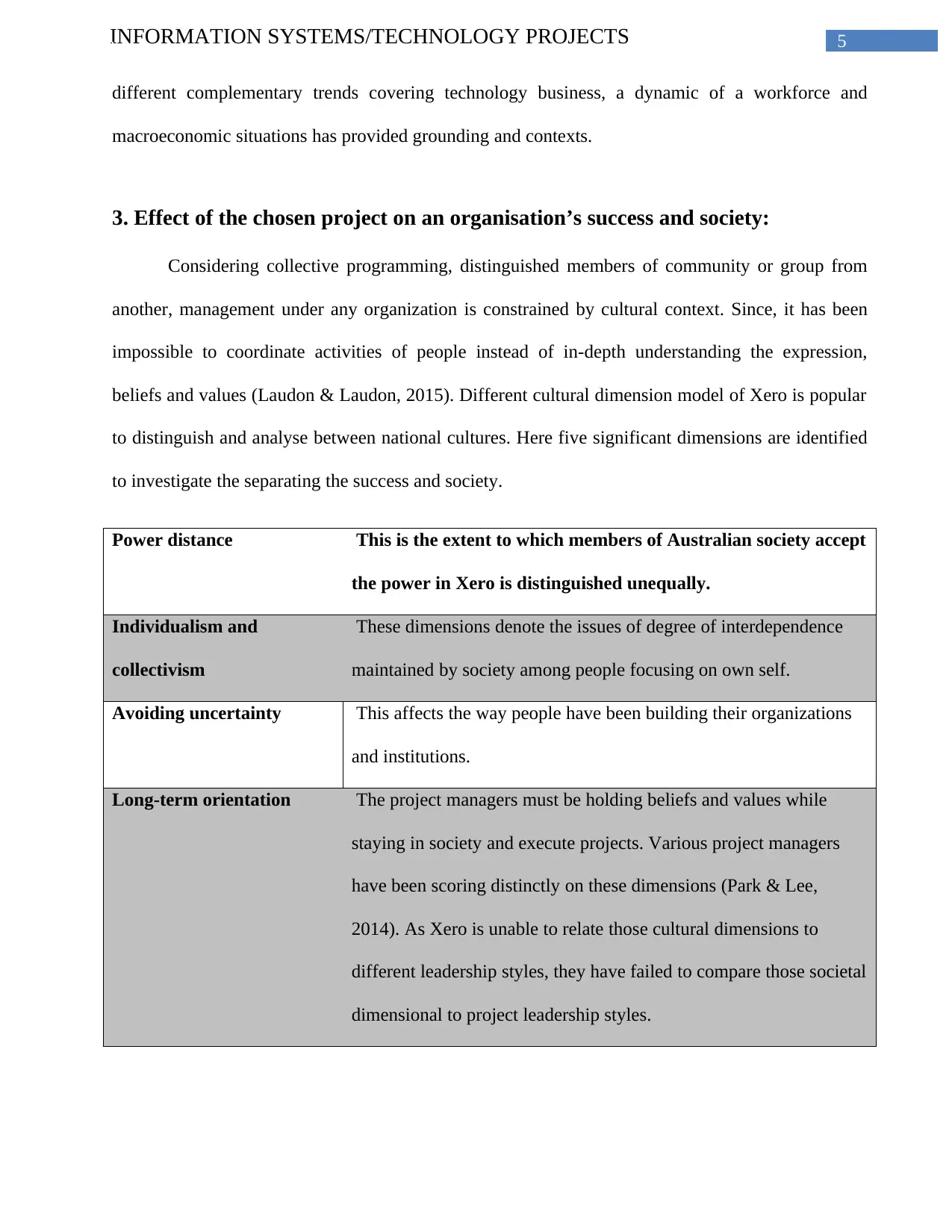
5INFORMATION SYSTEMS/TECHNOLOGY PROJECTS
different complementary trends covering technology business, a dynamic of a workforce and
macroeconomic situations has provided grounding and contexts.
3. Effect of the chosen project on an organisation’s success and society:
Considering collective programming, distinguished members of community or group from
another, management under any organization is constrained by cultural context. Since, it has been
impossible to coordinate activities of people instead of in-depth understanding the expression,
beliefs and values (Laudon & Laudon, 2015). Different cultural dimension model of Xero is popular
to distinguish and analyse between national cultures. Here five significant dimensions are identified
to investigate the separating the success and society.
Power distance This is the extent to which members of Australian society accept
the power in Xero is distinguished unequally.
Individualism and
collectivism
These dimensions denote the issues of degree of interdependence
maintained by society among people focusing on own self.
Avoiding uncertainty This affects the way people have been building their organizations
and institutions.
Long-term orientation The project managers must be holding beliefs and values while
staying in society and execute projects. Various project managers
have been scoring distinctly on these dimensions (Park & Lee,
2014). As Xero is unable to relate those cultural dimensions to
different leadership styles, they have failed to compare those societal
dimensional to project leadership styles.
different complementary trends covering technology business, a dynamic of a workforce and
macroeconomic situations has provided grounding and contexts.
3. Effect of the chosen project on an organisation’s success and society:
Considering collective programming, distinguished members of community or group from
another, management under any organization is constrained by cultural context. Since, it has been
impossible to coordinate activities of people instead of in-depth understanding the expression,
beliefs and values (Laudon & Laudon, 2015). Different cultural dimension model of Xero is popular
to distinguish and analyse between national cultures. Here five significant dimensions are identified
to investigate the separating the success and society.
Power distance This is the extent to which members of Australian society accept
the power in Xero is distinguished unequally.
Individualism and
collectivism
These dimensions denote the issues of degree of interdependence
maintained by society among people focusing on own self.
Avoiding uncertainty This affects the way people have been building their organizations
and institutions.
Long-term orientation The project managers must be holding beliefs and values while
staying in society and execute projects. Various project managers
have been scoring distinctly on these dimensions (Park & Lee,
2014). As Xero is unable to relate those cultural dimensions to
different leadership styles, they have failed to compare those societal
dimensional to project leadership styles.
⊘ This is a preview!⊘
Do you want full access?
Subscribe today to unlock all pages.

Trusted by 1+ million students worldwide
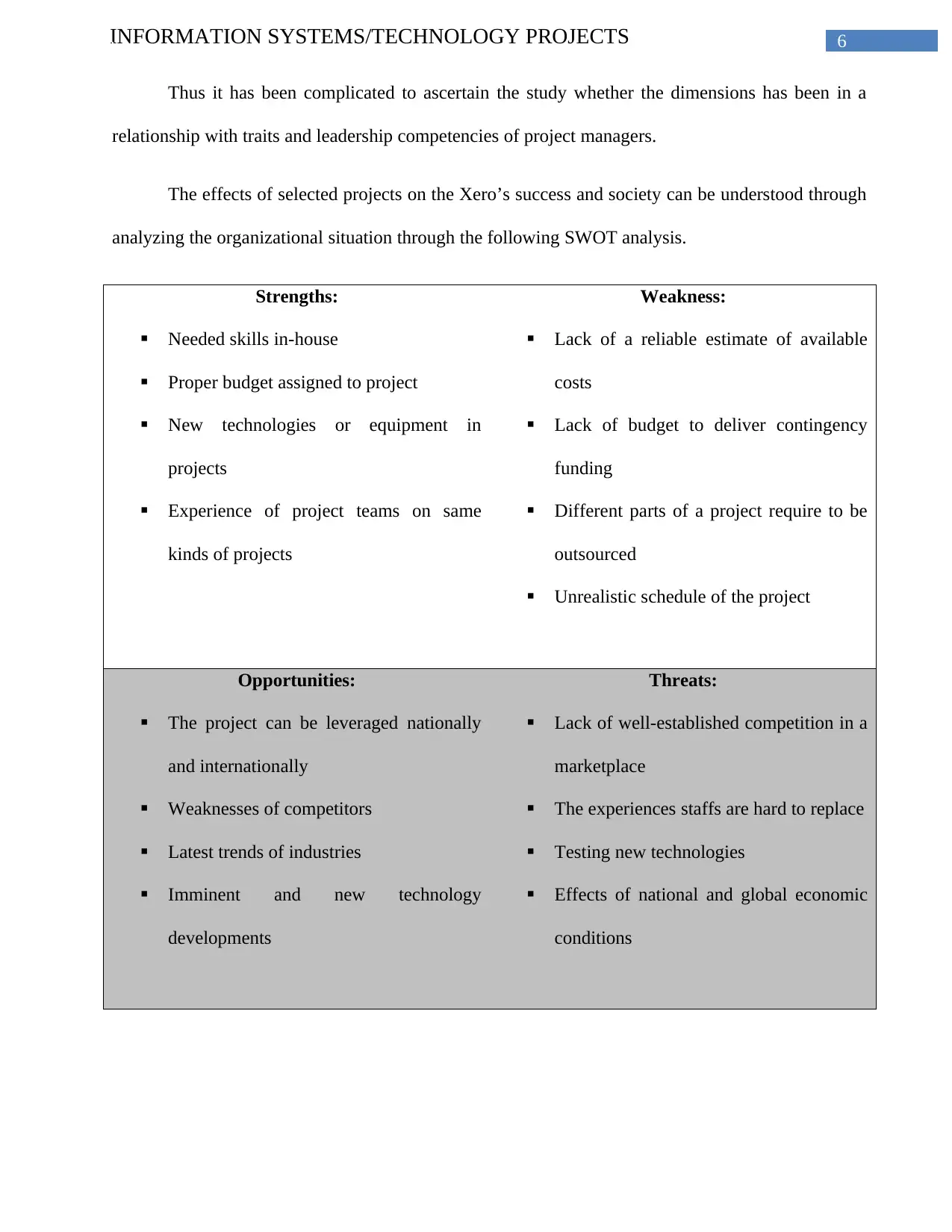
6INFORMATION SYSTEMS/TECHNOLOGY PROJECTS
Thus it has been complicated to ascertain the study whether the dimensions has been in a
relationship with traits and leadership competencies of project managers.
The effects of selected projects on the Xero’s success and society can be understood through
analyzing the organizational situation through the following SWOT analysis.
Strengths:
Needed skills in-house
Proper budget assigned to project
New technologies or equipment in
projects
Experience of project teams on same
kinds of projects
Weakness:
Lack of a reliable estimate of available
costs
Lack of budget to deliver contingency
funding
Different parts of a project require to be
outsourced
Unrealistic schedule of the project
Opportunities:
The project can be leveraged nationally
and internationally
Weaknesses of competitors
Latest trends of industries
Imminent and new technology
developments
Threats:
Lack of well-established competition in a
marketplace
The experiences staffs are hard to replace
Testing new technologies
Effects of national and global economic
conditions
Thus it has been complicated to ascertain the study whether the dimensions has been in a
relationship with traits and leadership competencies of project managers.
The effects of selected projects on the Xero’s success and society can be understood through
analyzing the organizational situation through the following SWOT analysis.
Strengths:
Needed skills in-house
Proper budget assigned to project
New technologies or equipment in
projects
Experience of project teams on same
kinds of projects
Weakness:
Lack of a reliable estimate of available
costs
Lack of budget to deliver contingency
funding
Different parts of a project require to be
outsourced
Unrealistic schedule of the project
Opportunities:
The project can be leveraged nationally
and internationally
Weaknesses of competitors
Latest trends of industries
Imminent and new technology
developments
Threats:
Lack of well-established competition in a
marketplace
The experiences staffs are hard to replace
Testing new technologies
Effects of national and global economic
conditions
Paraphrase This Document
Need a fresh take? Get an instant paraphrase of this document with our AI Paraphraser
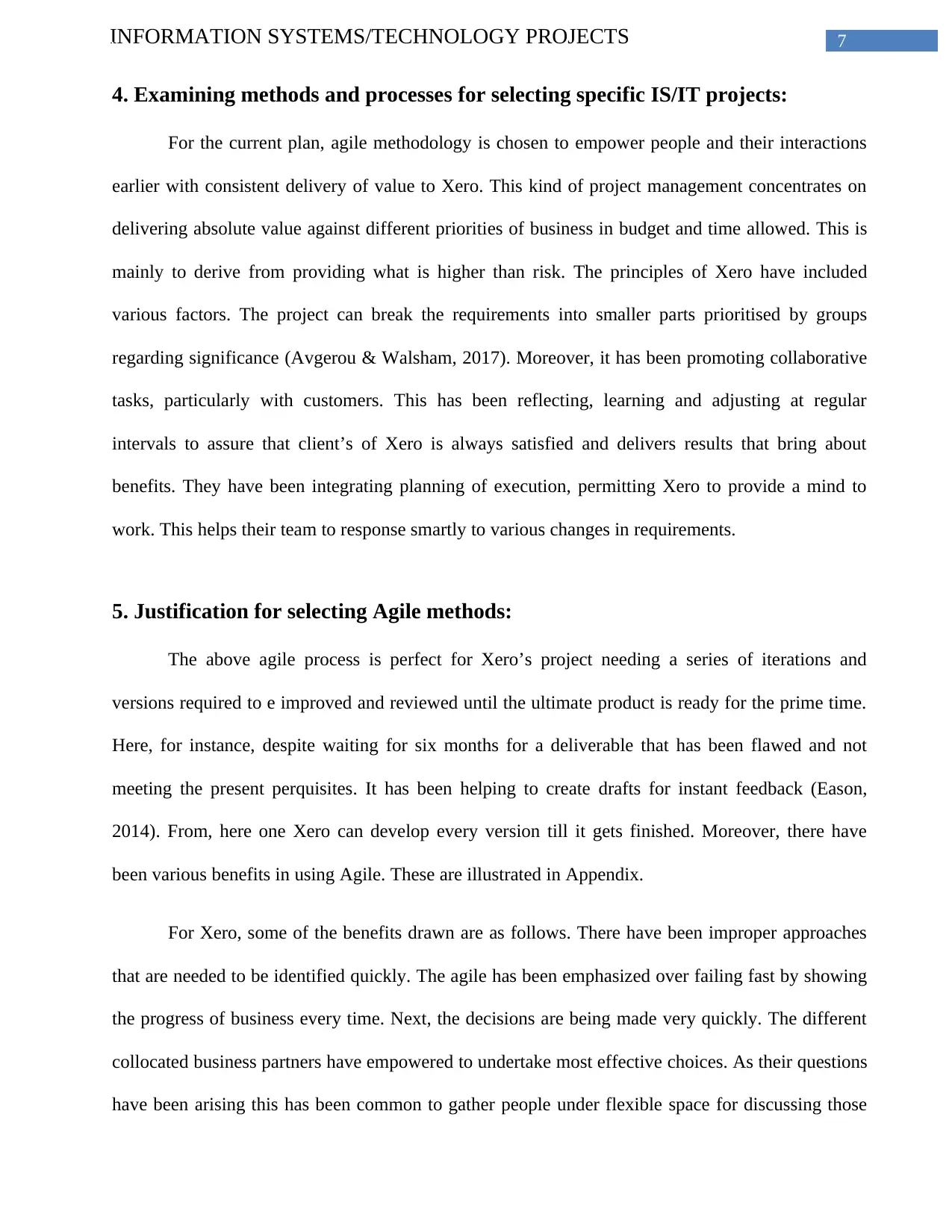
7INFORMATION SYSTEMS/TECHNOLOGY PROJECTS
4. Examining methods and processes for selecting specific IS/IT projects:
For the current plan, agile methodology is chosen to empower people and their interactions
earlier with consistent delivery of value to Xero. This kind of project management concentrates on
delivering absolute value against different priorities of business in budget and time allowed. This is
mainly to derive from providing what is higher than risk. The principles of Xero have included
various factors. The project can break the requirements into smaller parts prioritised by groups
regarding significance (Avgerou & Walsham, 2017). Moreover, it has been promoting collaborative
tasks, particularly with customers. This has been reflecting, learning and adjusting at regular
intervals to assure that client’s of Xero is always satisfied and delivers results that bring about
benefits. They have been integrating planning of execution, permitting Xero to provide a mind to
work. This helps their team to response smartly to various changes in requirements.
5. Justification for selecting Agile methods:
The above agile process is perfect for Xero’s project needing a series of iterations and
versions required to e improved and reviewed until the ultimate product is ready for the prime time.
Here, for instance, despite waiting for six months for a deliverable that has been flawed and not
meeting the present perquisites. It has been helping to create drafts for instant feedback (Eason,
2014). From, here one Xero can develop every version till it gets finished. Moreover, there have
been various benefits in using Agile. These are illustrated in Appendix.
For Xero, some of the benefits drawn are as follows. There have been improper approaches
that are needed to be identified quickly. The agile has been emphasized over failing fast by showing
the progress of business every time. Next, the decisions are being made very quickly. The different
collocated business partners have empowered to undertake most effective choices. As their questions
have been arising this has been common to gather people under flexible space for discussing those
4. Examining methods and processes for selecting specific IS/IT projects:
For the current plan, agile methodology is chosen to empower people and their interactions
earlier with consistent delivery of value to Xero. This kind of project management concentrates on
delivering absolute value against different priorities of business in budget and time allowed. This is
mainly to derive from providing what is higher than risk. The principles of Xero have included
various factors. The project can break the requirements into smaller parts prioritised by groups
regarding significance (Avgerou & Walsham, 2017). Moreover, it has been promoting collaborative
tasks, particularly with customers. This has been reflecting, learning and adjusting at regular
intervals to assure that client’s of Xero is always satisfied and delivers results that bring about
benefits. They have been integrating planning of execution, permitting Xero to provide a mind to
work. This helps their team to response smartly to various changes in requirements.
5. Justification for selecting Agile methods:
The above agile process is perfect for Xero’s project needing a series of iterations and
versions required to e improved and reviewed until the ultimate product is ready for the prime time.
Here, for instance, despite waiting for six months for a deliverable that has been flawed and not
meeting the present perquisites. It has been helping to create drafts for instant feedback (Eason,
2014). From, here one Xero can develop every version till it gets finished. Moreover, there have
been various benefits in using Agile. These are illustrated in Appendix.
For Xero, some of the benefits drawn are as follows. There have been improper approaches
that are needed to be identified quickly. The agile has been emphasized over failing fast by showing
the progress of business every time. Next, the decisions are being made very quickly. The different
collocated business partners have empowered to undertake most effective choices. As their questions
have been arising this has been common to gather people under flexible space for discussing those
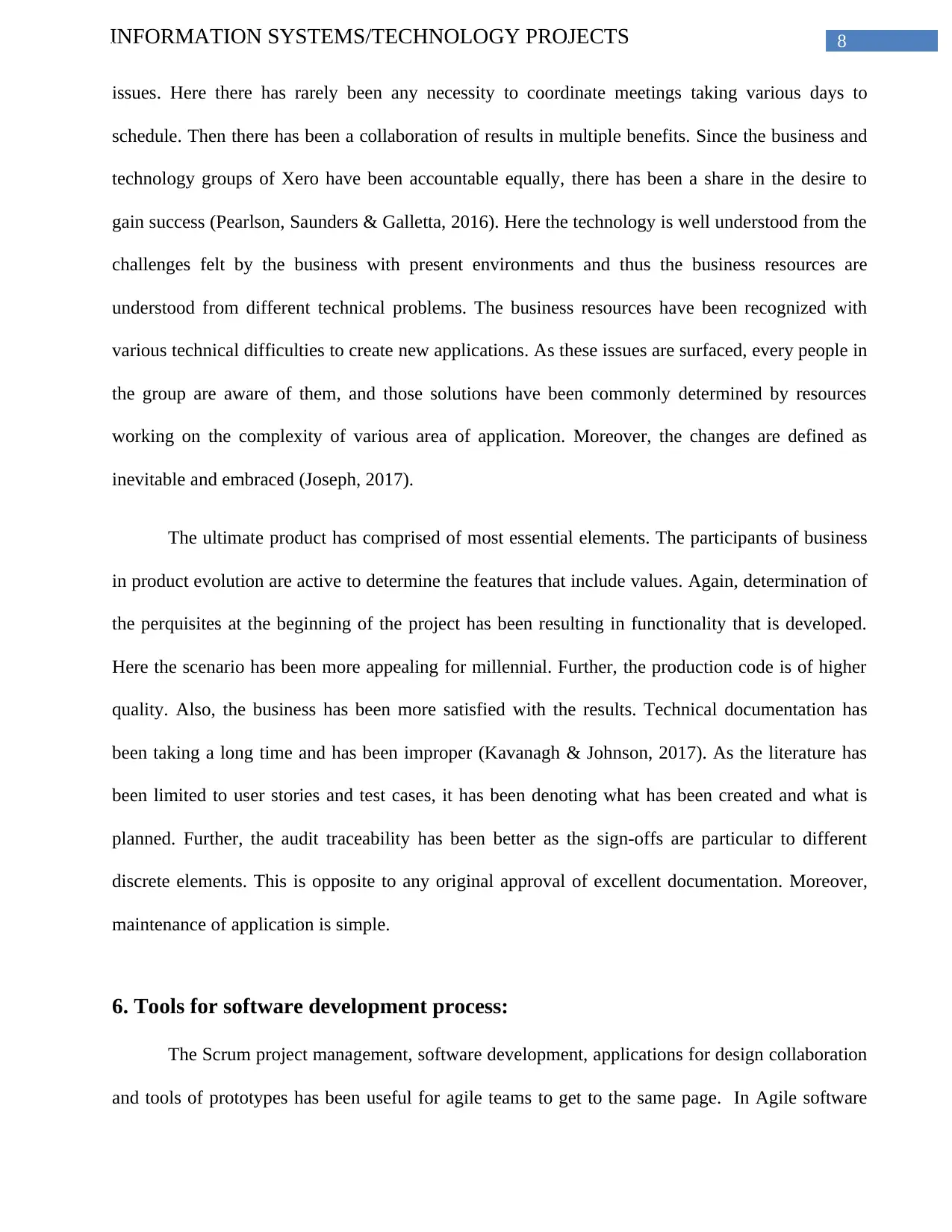
8INFORMATION SYSTEMS/TECHNOLOGY PROJECTS
issues. Here there has rarely been any necessity to coordinate meetings taking various days to
schedule. Then there has been a collaboration of results in multiple benefits. Since the business and
technology groups of Xero have been accountable equally, there has been a share in the desire to
gain success (Pearlson, Saunders & Galletta, 2016). Here the technology is well understood from the
challenges felt by the business with present environments and thus the business resources are
understood from different technical problems. The business resources have been recognized with
various technical difficulties to create new applications. As these issues are surfaced, every people in
the group are aware of them, and those solutions have been commonly determined by resources
working on the complexity of various area of application. Moreover, the changes are defined as
inevitable and embraced (Joseph, 2017).
The ultimate product has comprised of most essential elements. The participants of business
in product evolution are active to determine the features that include values. Again, determination of
the perquisites at the beginning of the project has been resulting in functionality that is developed.
Here the scenario has been more appealing for millennial. Further, the production code is of higher
quality. Also, the business has been more satisfied with the results. Technical documentation has
been taking a long time and has been improper (Kavanagh & Johnson, 2017). As the literature has
been limited to user stories and test cases, it has been denoting what has been created and what is
planned. Further, the audit traceability has been better as the sign-offs are particular to different
discrete elements. This is opposite to any original approval of excellent documentation. Moreover,
maintenance of application is simple.
6. Tools for software development process:
The Scrum project management, software development, applications for design collaboration
and tools of prototypes has been useful for agile teams to get to the same page. In Agile software
issues. Here there has rarely been any necessity to coordinate meetings taking various days to
schedule. Then there has been a collaboration of results in multiple benefits. Since the business and
technology groups of Xero have been accountable equally, there has been a share in the desire to
gain success (Pearlson, Saunders & Galletta, 2016). Here the technology is well understood from the
challenges felt by the business with present environments and thus the business resources are
understood from different technical problems. The business resources have been recognized with
various technical difficulties to create new applications. As these issues are surfaced, every people in
the group are aware of them, and those solutions have been commonly determined by resources
working on the complexity of various area of application. Moreover, the changes are defined as
inevitable and embraced (Joseph, 2017).
The ultimate product has comprised of most essential elements. The participants of business
in product evolution are active to determine the features that include values. Again, determination of
the perquisites at the beginning of the project has been resulting in functionality that is developed.
Here the scenario has been more appealing for millennial. Further, the production code is of higher
quality. Also, the business has been more satisfied with the results. Technical documentation has
been taking a long time and has been improper (Kavanagh & Johnson, 2017). As the literature has
been limited to user stories and test cases, it has been denoting what has been created and what is
planned. Further, the audit traceability has been better as the sign-offs are particular to different
discrete elements. This is opposite to any original approval of excellent documentation. Moreover,
maintenance of application is simple.
6. Tools for software development process:
The Scrum project management, software development, applications for design collaboration
and tools of prototypes has been useful for agile teams to get to the same page. In Agile software
⊘ This is a preview!⊘
Do you want full access?
Subscribe today to unlock all pages.

Trusted by 1+ million students worldwide
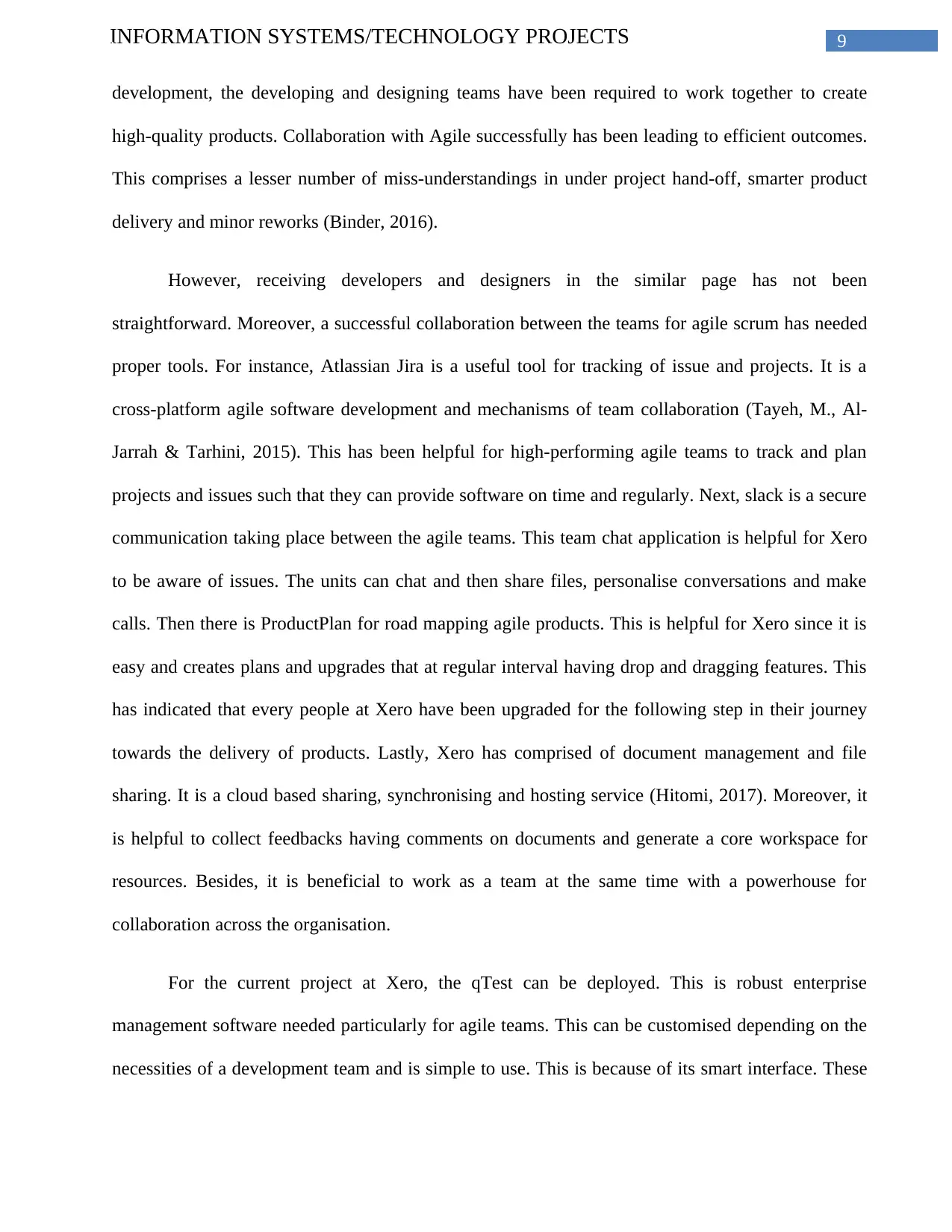
9INFORMATION SYSTEMS/TECHNOLOGY PROJECTS
development, the developing and designing teams have been required to work together to create
high-quality products. Collaboration with Agile successfully has been leading to efficient outcomes.
This comprises a lesser number of miss-understandings in under project hand-off, smarter product
delivery and minor reworks (Binder, 2016).
However, receiving developers and designers in the similar page has not been
straightforward. Moreover, a successful collaboration between the teams for agile scrum has needed
proper tools. For instance, Atlassian Jira is a useful tool for tracking of issue and projects. It is a
cross-platform agile software development and mechanisms of team collaboration (Tayeh, M., Al-
Jarrah & Tarhini, 2015). This has been helpful for high-performing agile teams to track and plan
projects and issues such that they can provide software on time and regularly. Next, slack is a secure
communication taking place between the agile teams. This team chat application is helpful for Xero
to be aware of issues. The units can chat and then share files, personalise conversations and make
calls. Then there is ProductPlan for road mapping agile products. This is helpful for Xero since it is
easy and creates plans and upgrades that at regular interval having drop and dragging features. This
has indicated that every people at Xero have been upgraded for the following step in their journey
towards the delivery of products. Lastly, Xero has comprised of document management and file
sharing. It is a cloud based sharing, synchronising and hosting service (Hitomi, 2017). Moreover, it
is helpful to collect feedbacks having comments on documents and generate a core workspace for
resources. Besides, it is beneficial to work as a team at the same time with a powerhouse for
collaboration across the organisation.
For the current project at Xero, the qTest can be deployed. This is robust enterprise
management software needed particularly for agile teams. This can be customised depending on the
necessities of a development team and is simple to use. This is because of its smart interface. These
development, the developing and designing teams have been required to work together to create
high-quality products. Collaboration with Agile successfully has been leading to efficient outcomes.
This comprises a lesser number of miss-understandings in under project hand-off, smarter product
delivery and minor reworks (Binder, 2016).
However, receiving developers and designers in the similar page has not been
straightforward. Moreover, a successful collaboration between the teams for agile scrum has needed
proper tools. For instance, Atlassian Jira is a useful tool for tracking of issue and projects. It is a
cross-platform agile software development and mechanisms of team collaboration (Tayeh, M., Al-
Jarrah & Tarhini, 2015). This has been helpful for high-performing agile teams to track and plan
projects and issues such that they can provide software on time and regularly. Next, slack is a secure
communication taking place between the agile teams. This team chat application is helpful for Xero
to be aware of issues. The units can chat and then share files, personalise conversations and make
calls. Then there is ProductPlan for road mapping agile products. This is helpful for Xero since it is
easy and creates plans and upgrades that at regular interval having drop and dragging features. This
has indicated that every people at Xero have been upgraded for the following step in their journey
towards the delivery of products. Lastly, Xero has comprised of document management and file
sharing. It is a cloud based sharing, synchronising and hosting service (Hitomi, 2017). Moreover, it
is helpful to collect feedbacks having comments on documents and generate a core workspace for
resources. Besides, it is beneficial to work as a team at the same time with a powerhouse for
collaboration across the organisation.
For the current project at Xero, the qTest can be deployed. This is robust enterprise
management software needed particularly for agile teams. This can be customised depending on the
necessities of a development team and is simple to use. This is because of its smart interface. These
Paraphrase This Document
Need a fresh take? Get an instant paraphrase of this document with our AI Paraphraser
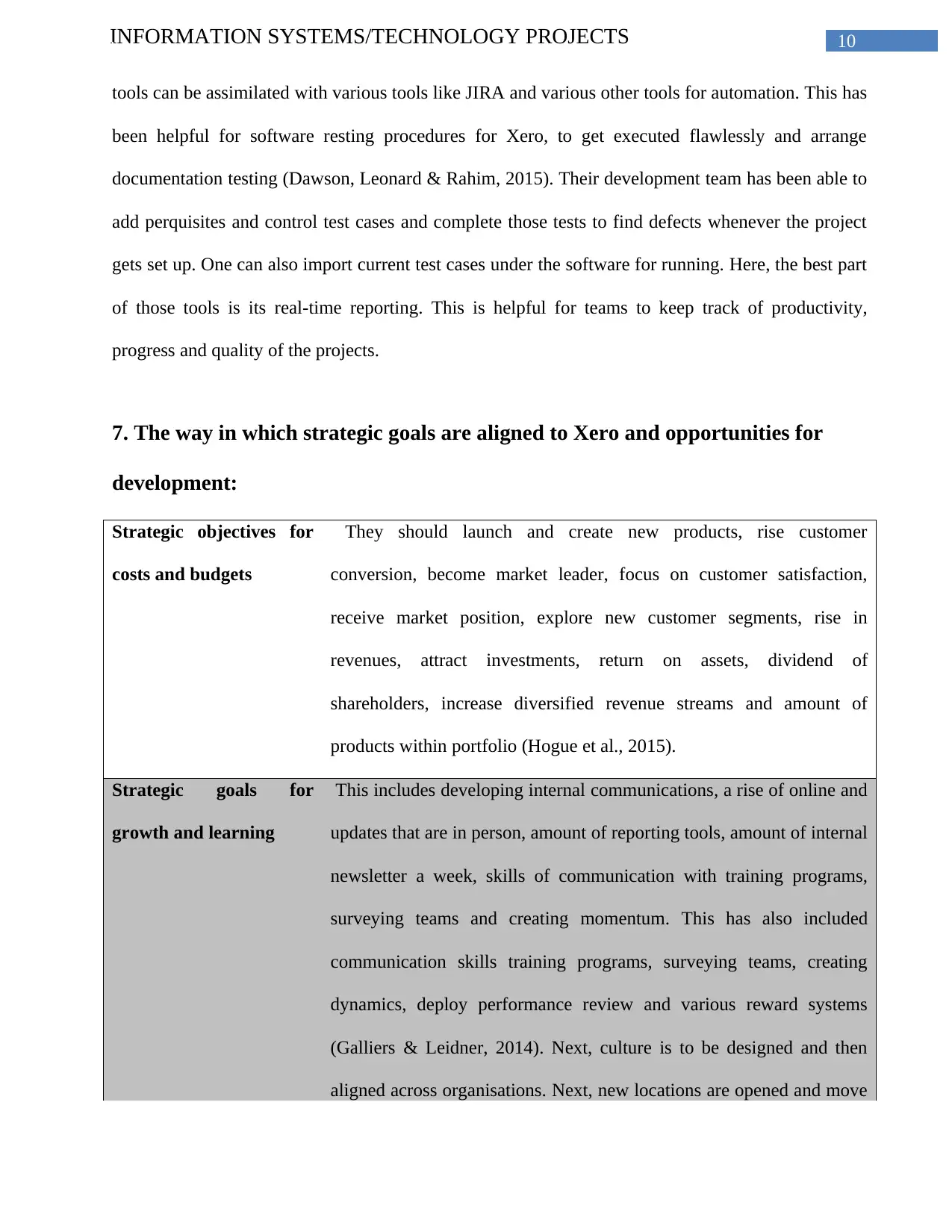
10INFORMATION SYSTEMS/TECHNOLOGY PROJECTS
tools can be assimilated with various tools like JIRA and various other tools for automation. This has
been helpful for software resting procedures for Xero, to get executed flawlessly and arrange
documentation testing (Dawson, Leonard & Rahim, 2015). Their development team has been able to
add perquisites and control test cases and complete those tests to find defects whenever the project
gets set up. One can also import current test cases under the software for running. Here, the best part
of those tools is its real-time reporting. This is helpful for teams to keep track of productivity,
progress and quality of the projects.
7. The way in which strategic goals are aligned to Xero and opportunities for
development:
Strategic objectives for
costs and budgets
They should launch and create new products, rise customer
conversion, become market leader, focus on customer satisfaction,
receive market position, explore new customer segments, rise in
revenues, attract investments, return on assets, dividend of
shareholders, increase diversified revenue streams and amount of
products within portfolio (Hogue et al., 2015).
Strategic goals for
growth and learning
This includes developing internal communications, a rise of online and
updates that are in person, amount of reporting tools, amount of internal
newsletter a week, skills of communication with training programs,
surveying teams and creating momentum. This has also included
communication skills training programs, surveying teams, creating
dynamics, deploy performance review and various reward systems
(Galliers & Leidner, 2014). Next, culture is to be designed and then
aligned across organisations. Next, new locations are opened and move
tools can be assimilated with various tools like JIRA and various other tools for automation. This has
been helpful for software resting procedures for Xero, to get executed flawlessly and arrange
documentation testing (Dawson, Leonard & Rahim, 2015). Their development team has been able to
add perquisites and control test cases and complete those tests to find defects whenever the project
gets set up. One can also import current test cases under the software for running. Here, the best part
of those tools is its real-time reporting. This is helpful for teams to keep track of productivity,
progress and quality of the projects.
7. The way in which strategic goals are aligned to Xero and opportunities for
development:
Strategic objectives for
costs and budgets
They should launch and create new products, rise customer
conversion, become market leader, focus on customer satisfaction,
receive market position, explore new customer segments, rise in
revenues, attract investments, return on assets, dividend of
shareholders, increase diversified revenue streams and amount of
products within portfolio (Hogue et al., 2015).
Strategic goals for
growth and learning
This includes developing internal communications, a rise of online and
updates that are in person, amount of reporting tools, amount of internal
newsletter a week, skills of communication with training programs,
surveying teams and creating momentum. This has also included
communication skills training programs, surveying teams, creating
dynamics, deploy performance review and various reward systems
(Galliers & Leidner, 2014). Next, culture is to be designed and then
aligned across organisations. Next, new locations are opened and move
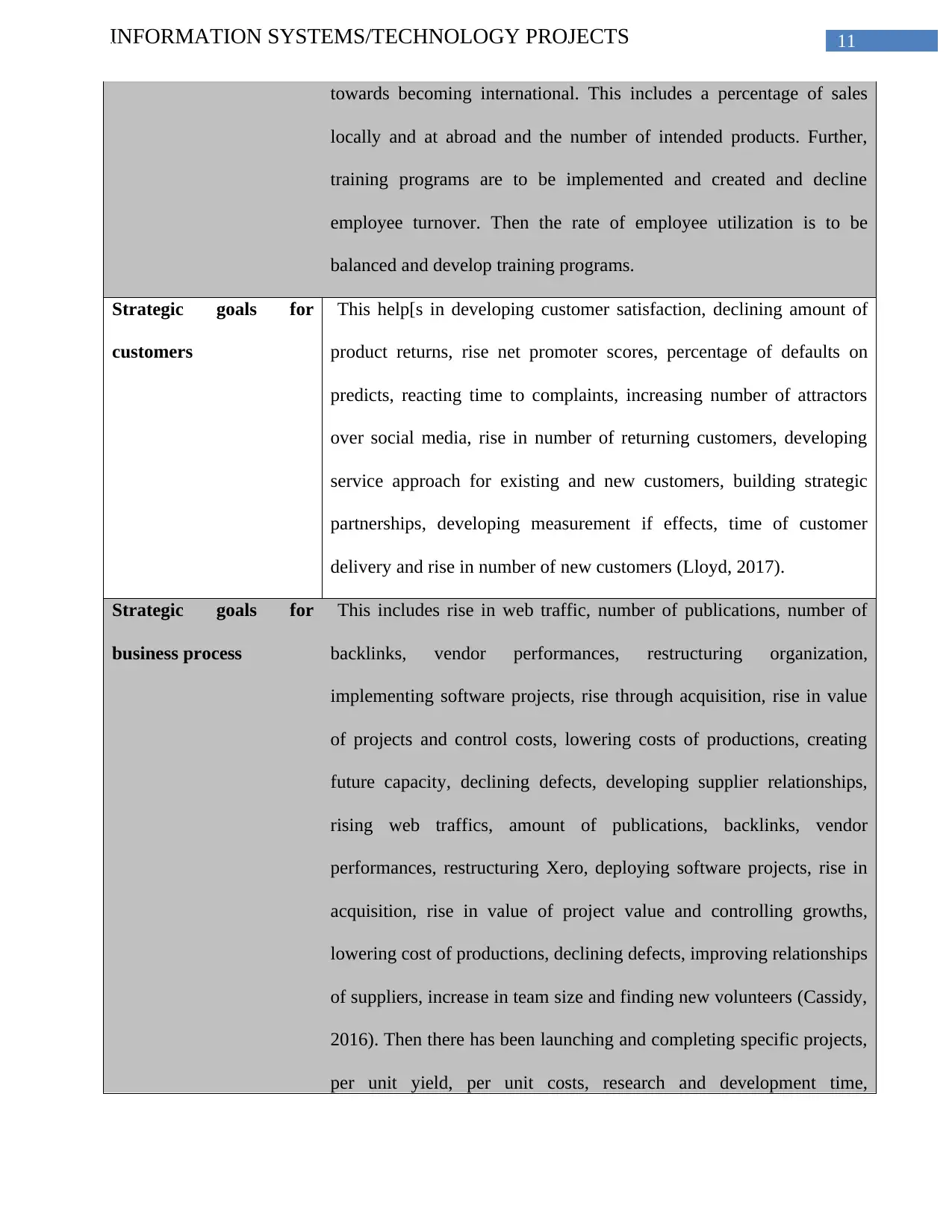
11INFORMATION SYSTEMS/TECHNOLOGY PROJECTS
towards becoming international. This includes a percentage of sales
locally and at abroad and the number of intended products. Further,
training programs are to be implemented and created and decline
employee turnover. Then the rate of employee utilization is to be
balanced and develop training programs.
Strategic goals for
customers
This help[s in developing customer satisfaction, declining amount of
product returns, rise net promoter scores, percentage of defaults on
predicts, reacting time to complaints, increasing number of attractors
over social media, rise in number of returning customers, developing
service approach for existing and new customers, building strategic
partnerships, developing measurement if effects, time of customer
delivery and rise in number of new customers (Lloyd, 2017).
Strategic goals for
business process
This includes rise in web traffic, number of publications, number of
backlinks, vendor performances, restructuring organization,
implementing software projects, rise through acquisition, rise in value
of projects and control costs, lowering costs of productions, creating
future capacity, declining defects, developing supplier relationships,
rising web traffics, amount of publications, backlinks, vendor
performances, restructuring Xero, deploying software projects, rise in
acquisition, rise in value of project value and controlling growths,
lowering cost of productions, declining defects, improving relationships
of suppliers, increase in team size and finding new volunteers (Cassidy,
2016). Then there has been launching and completing specific projects,
per unit yield, per unit costs, research and development time,
towards becoming international. This includes a percentage of sales
locally and at abroad and the number of intended products. Further,
training programs are to be implemented and created and decline
employee turnover. Then the rate of employee utilization is to be
balanced and develop training programs.
Strategic goals for
customers
This help[s in developing customer satisfaction, declining amount of
product returns, rise net promoter scores, percentage of defaults on
predicts, reacting time to complaints, increasing number of attractors
over social media, rise in number of returning customers, developing
service approach for existing and new customers, building strategic
partnerships, developing measurement if effects, time of customer
delivery and rise in number of new customers (Lloyd, 2017).
Strategic goals for
business process
This includes rise in web traffic, number of publications, number of
backlinks, vendor performances, restructuring organization,
implementing software projects, rise through acquisition, rise in value
of projects and control costs, lowering costs of productions, creating
future capacity, declining defects, developing supplier relationships,
rising web traffics, amount of publications, backlinks, vendor
performances, restructuring Xero, deploying software projects, rise in
acquisition, rise in value of project value and controlling growths,
lowering cost of productions, declining defects, improving relationships
of suppliers, increase in team size and finding new volunteers (Cassidy,
2016). Then there has been launching and completing specific projects,
per unit yield, per unit costs, research and development time,
⊘ This is a preview!⊘
Do you want full access?
Subscribe today to unlock all pages.

Trusted by 1+ million students worldwide
1 out of 21
Related Documents
Your All-in-One AI-Powered Toolkit for Academic Success.
+13062052269
info@desklib.com
Available 24*7 on WhatsApp / Email
![[object Object]](/_next/static/media/star-bottom.7253800d.svg)
Unlock your academic potential
Copyright © 2020–2025 A2Z Services. All Rights Reserved. Developed and managed by ZUCOL.




